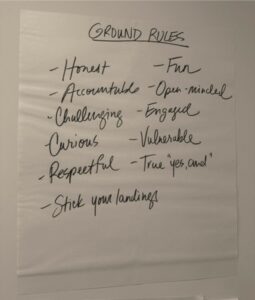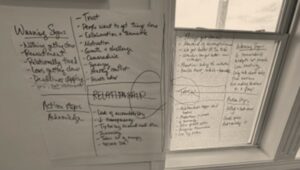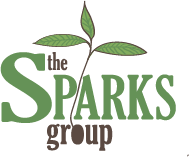Strategic Planning That Hits
I was recently asked to facilitate the strategic planning retreat for a long-term client of The Sparks Group. I thought I would share the story of this work to illustrate how both developmental and business objectives can be accomplished in an integrated fashion, making the investment of senior leader time and effort have a maximum payoff.
It’s expensive in every way to take an entire senior leadership team away from the business for several days to work on the business. It’s even more expensive if you waste your time and don’t get the outcomes you need.
What can you get out of it? A lot. Here’s how this team made the most of their investment of time, money, and energy.

Not a bad spot for a planning retreat.
When the CEO and I initially talked about what he wanted to accomplish during the planning retreat, he talked about how they were in the initial stages of adopting the Enterprise Operating System (EOS) framework, and he wanted to continue working through the Vision Traction Organizer tool (VTO). They already had solid values and an overarching vision but needed to work on a more specific long-term target, three and one-year plans, goals for the year, as well as marketing differentiators.
That was the tactical work. At a deeper level, he sensed the leadership team wasn’t aligned around the vision or committed to making the vision a reality. He also sensed a general disconnection among and across the team, so he asked for this to be addressed as well.
Even though I’ve worked with this team for years and know them well, when our team brainstormed how to approach the retreat, Anna thought discovery interviews would be a good way to see if other team members shared the same perspective as the CEO.
It turns out that was a good idea. Themes that emerged from the discovery effort included confirmation that their office renovation, which left them somewhat dislocated for much of the year, had impacted connectivity and morale. As a result, they were tiptoeing around each other and making decisions (or failing to make timely decisions) that served the best interests of the business.
They agreed that while they had an overarching vision, it wasn’t specific enough to drive alignment on the long-term outcome they wanted, or what they needed to do to incrementally move in that direction. And lastly, they reported the CEO was asserting his role too often and too strongly and was taking things on that should be delegated to others or decided on with more participation from the leadership team.
The CEO’s requests and the themes from discovery drove the design of the planning retreat. For prework, I asked the team to read an article on differentiators and think about the company’s differentiators. I also asked them to think about a towering strength of their own that was a unique contribution to the team, and an area of opportunity they were committed to working on. To be clear, this was not a request for strengths or weaknesses in skills (i.e. I need to learn how to delegate better), but a focus on mindset.

The team brainstormed ground rules after setting individual intentions for the time together.
The retreat began on a Sunday evening with a group dinner, and I did a short two-part introduction. Using Visual Explorer cards from the Center for Creative Leadership, I asked the team to pick an image representing their intention for the planning retreat. Then I provided conversation starters from The School of Life for them to pass around and ask each other during dinner. (What would you love to change about the way you typically think? What do you still want to do before you die? In what ways might you be a difficult person to work with or for? What are you stubborn about?) One of the team members then asked a very vulnerable question of his own, and the team had deep, rich dialogue over dinner.
The following day we reviewed the findings from the discovery interviews, and this provided an opening for discussion around the CEO’s unhelpful tendencies that had cropped up. This leader gets a lot of credit for taking feedback well and being open about his opportunities with his team. I facilitated them through a polarity map where they worked on the balance between relationship and task. Then we rolled into more traditional strategic planning work – nailing down differentiators, setting revenue and profit targets for seven years, three years, and one year out.

Polarity map for relationship and task.
The following morning began with more developmental work. Each member of the team shared their prework reflections on a strength and an opportunity in how they show up on the team, laying the foundation for more work in this vein after the retreat. Then, the one-year plan was fleshed out into strategic goals for the year and “rocks” in EOS parlance for each quarter during the year.
What did they accomplish? A lot. They ironed out a concrete long-term vision and outlined major milestones along the way. They brought the most level of detail to the near-term, identifying areas of focus for the year and committing to quarterly milestones. Just as important, they gained perspective on the interpersonal dynamics they had created that weren’t serving them, and deepened their vulnerability and honesty with each other, putting social capital in the bank that will pay dividends as they put effort and focus on a clearer future state.
All of this is magnified when you have an outside facilitator and the design is bespoke, not off the shelf. There are many developmental and strategic planning frameworks out there. But it’s unlikely that anything standard will meet the needs of your team perfectly. Taking time to make the most of your strategic planning investment is smart leadership.
How can you make the most of your next offsite or planning retreat?

Client testimonial
Jessica
Founder & CEO
The Sparks Group

